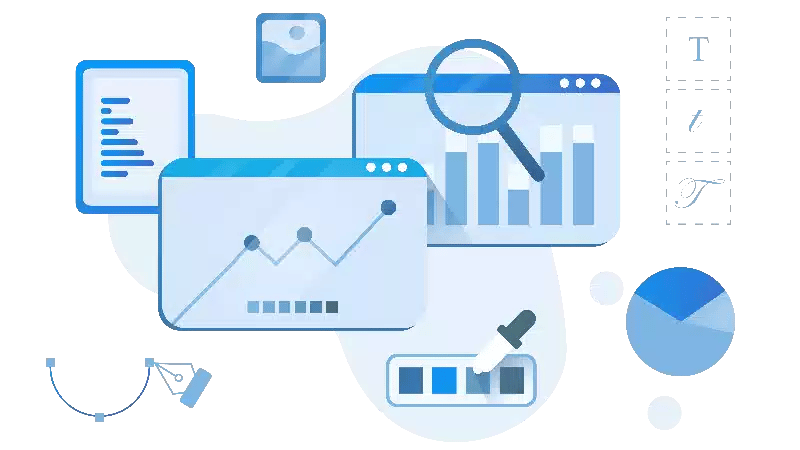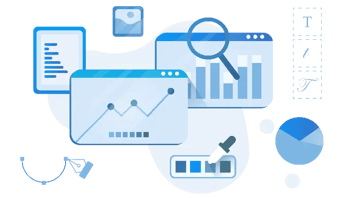What Is Growth-Driven Design? Best Practices and Tips To Get Started
Growth-Driven Design (GDD) is an agile process of designing new websites or performing a website redesign that focuses on continuous optimization and improvement based on data and user feedback. Growth-driven design approaches yield better ROI and improved user experience with decision-making based on real user data.

Why Does Growth-Driven Design Matter?
-
90% of businesses fail to achieve their website goals. It's no secret that traditional web design methodologies often fall short for many businesses. Growth-Driven Design (GDD) can help businesses achieve their website goals more successfully by utilizing a more data-driven approach.
-
GDD can increase website conversion rates by up to 400%. The GDD process has proven to be a game-changer in boosting website conversion rates. By utilizing GDD, businesses can make changes or redesign their website based on data and user feedback, potentially leading to significant improvements in conversion rates.
-
GDD can save businesses up to 50% on website design and development costs. The Growth-Driven Design methodology offers a cost-effective website development and improvement solution. It enables businesses to sidestep the hefty upfront costs associated with traditional website development while allowing them to save money through gradual, incremental adjustments to their site over time.
-
GDD can shorten the website design process by up to 50%. With GDD, businesses can launch their websites faster, skipping traditional development's time-consuming planning and design stages. This approach allows for early user feedback, leading to quicker and more agile website development, whether upgrading an existing website or building a new website using GDD.
-
GDD can improve website usability by up to 30%. By utilizing Growth-Driven Design, businesses can enhance the usability of their websites by making gradual adjustments based on data and user feedback. These minor changes can lead to significant improvements in usability, ultimately resulting in increased website traffic and conversion rates.
Using Growth-Driven Design
The core stages of the Growth-Driven Design work to be completed include the following components:
-
Strategy and planning: This involves defining the goals and objectives of the website, conducting market and audience research, and creating a plan for how the website will support the growth of the business.
-
Launchpad website: This is a minimally viable version of the website that is quickly developed and launched, serving as a starting point for future improvements.
-
Continuous improvement: The interactive, ongoing process of gathering data, testing hypotheses, and making minor, incremental improvements to the website to drive growth.
-
User experience (UX) design: This involves designing the website in a way that is intuitive and enjoyable for users to improve engagement and conversion rates.
-
Conversion rate optimization (CRO): Conversion Rate Optimization improves the website's conversion rate by making changes that increase the likelihood of visitors taking the desired action, such as filling out a form or purchasing.
-
Analytics and measurement: This involves using tools such as Google Analytics to track the website's performance and measure the impact of improvements.
1. Strategy and planning
Strategy and planning define the fundamental assumptions of your approach; they ensure that the new site and the new design elements are aligned with the goals and objectives of the business. This process involves market and audience research to understand the needs and preferences of the target audience and the definition of key performance indicators (KPIs) to measure the website's success.
Set clear goals and objectives for the website, such as increasing traffic, generating leads, or improving user experience.
This will help to ensure that the website is designed and developed in a way that supports the overall growth of the business.
Develop the template of how the website will be developed and maintained over time. This includes defining the content and features that will be included on the website, as well as the processes and tools used to manage and optimize the site.
2. Launch pad website
The launch pad website is a minimal version of the website that is quickly developed and launched, serving as a starting point for future improvements. It's designed to be a more efficient and effective alternative to the traditional "waterfall" approach to web development, which involves designing and developing a complete website all at once and then launching it.
The launch pad site includes the core elements necessary to support the business and engage users, such as a homepage, key pages, and basic functionality. It's not meant to be a fully-featured website but a foundation to build and iterate over time. It represents the minimum viable starting point.
The launch pad approach allows businesses to get a website up and running quickly while allowing for flexibility and continuous improvement. This allows the website to evolve and adapt to the changing needs of the business and the market rather than becoming outdated or irrelevant.
3. Continuous improvement stage
Continuous improvement and building the next-level wish list is about using data, testing hypotheses, and making incremental improvements to the website to drive business growth. This is critical in the growth-driven design process because it allows the website to evolve and adapt rather than become stagnant or outdated.
There are several critical components to the continuous improvement process:
-
Data collection involves using tools like Google Analytics to track the website's performance and gather data on user behavior, conversion rates, and other vital metrics.
-
Hypothesis testing: Based on the data collected, hypotheses can be developed and tested to identify potential improvements to the website. For example, an idea might be that changing the color of a call-to-action button will increase the number of form submissions.
-
Implementation: Once a hypothesis has been tested and proven effective, the change can be implemented on the website.
-
Measurement: The impact of the change should be measured and analyzed to determine whether it had the desired effect on the website's performance.
The continuous improvement process allows businesses to make small, incremental changes to the website over time rather than trying to overhaul the entire site simultaneously as is found in traditional website redesign approaches.
This ensures that the website remains relevant and effective in driving growth.
4. User experience (UX) design
User experience (UX) design is designing a website in a way that is intuitive and enjoyable for users. UX design aims to improve engagement and conversion rates by making it easy for users to find what they are looking for and take desired actions, such as filling out a form or purchasing.
UX design involves considering factors such as the layout and organization of the website, the ease of navigation, the appearance, visual design, and the overall flow of the user journey. It also involves conducting user research and testing to understand how users interact with the website and identify areas for improvement.
Some of the critical considerations in UX design include the following:
-
Usability: How easy it is for users to accomplish their goals on the website.
-
Accessibility: Making sure the website is accessible to users with disabilities.
-
Findability: Ensuring users can easily find the content and information they want.
-
Persuasion: Designing the website in a way that persuades users to take desired actions.
-
Delight: Creating a positive, enjoyable user experience sets the website apart from competitors.
Improving a website's UX can help increase engagement, conversion rates, and overall user satisfaction.
5. Conversion rate optimization (CRO)
Conversion rate optimization (CRO) improves a website's conversion rate by making changes that increase the likelihood of visitors taking the desired action, such as filling out a form or purchasing. CRO aims to maximize the website's return on investment (ROI) by converting as many visitors as possible into leads or customers.
Many techniques can be used to optimize conversion rates, including A/B testing, landing page optimization, and usability testing. Some common tactics include:
-
Reducing friction: Making it easier for users to take desired actions by reducing the required steps, simplifying the process, or removing distractions.
-
Improving the value proposition: Communicating the benefits of taking the desired action and highlighting the value that users will receive.
-
Personalizing the experience: Customizing the website experience based on the user's location, behavior, or other factors to make it more relevant and engaging.
-
We are optimizing the call-to-action (CTA): Making the CTA prominent, clear, and compelling to encourage users to take the desired action.
By optimizing a website's conversion rate, businesses can increase their revenue and achieve better ROI from their online marketing efforts.
6. Analytics and measurement
Analytics and measurement are essential elements of growth-driven design because they allow businesses to track the website's performance and measure the impact of improvements. This helps to ensure that the website is aligned with the goals and objectives of the business and that efforts are focused on the most impactful areas.
Many tools and techniques can be used to build a peak-performing website, including:
-
Web analytics: Google Analytics can track website traffic, user behavior, conversion rates, and other vital metrics.
-
A/B testing: This involves testing two versions of a webpage or element (such as a call-to-action button) to see which performs better.
-
Customer feedback: Gathering user feedback through surveys, focus groups, or other methods can provide valuable insights into the website's effectiveness.
-
Heat mapping: Tools like Hotjar can create visual representations of where users click on a webpage, providing insights into areas of interest and engagement.
By analyzing and measuring the website's performance, businesses can make informed decisions about where to focus their efforts and make improvements to drive growth.
Benefits of Growth-Driven Web Design
There are many Growth-Driven Design benefits when using to develop and optimize websites, including:
-
Continuous improvement: By continuously gathering data and making minor, incremental improvements to the website, businesses can ensure that the website remains relevant and effective in driving growth.
-
Increased efficiency: The launch pad approach to web development allows businesses to get a website up and running quickly while allowing for flexibility and continuous improvement. This can be more efficient than the traditional "waterfall" approach, which involves designing and developing a complete website simultaneously and then launching it.
-
Better ROI: By focusing on conversion rate optimization and continuously improving the website, businesses can maximize the return on investment of their online marketing efforts.
-
Improved user experience: By designing the website with the user in mind and continuously gathering and acting on user feedback, businesses can create a better visitor experience and improve engagement and conversion rates.
-
Data-driven decision-making: By tracking key performance indicators (KPIs) and gathering data on the website's performance, businesses can make informed decisions about where to focus their efforts and make improvements to drive growth.
Recommended GDD Tools
Many tools can be used in the process of Growth-Driven Design, including:
-
Google Analytics: A web analytics tool that provides data on website traffic, user behavior, conversion rates, and other vital metrics.
-
A/B testing tools: Test two or more versions of a webpage or element (such as a call-to-action button) to see which performs better. Examples include HubSpot or Google Optimize.
-
User feedback: Gather user feedback through surveys, focus groups, or other methods. Examples include HubSpot and Qualtrics.
-
Heat mapping: Create visual representations of where users click on a webpage, providing insights into areas of interest and engagement. Examples include Hotjar and Crazy Egg.
-
Project management and collaboration: Manage and collaborate on the development and optimization of the website. Examples include ClickUp, Asana, and Trello.
-
Content management systems (CMS): These systems allow businesses to create, manage, and publish content on their website. Our recommendation? The HubSpot Content Hub.
Growth-Driven Design FAQs
Growth-driven design (GDD) is a methodology that emphasizes continuous learning and improvement to achieve business goals. It is an iterative process that involves three main stages: strategy, launch pad, and continuous improvement.
Stage 1: Strategy
The strategy stage involves defining business goals, understanding user behavior, and developing a plan to achieve those goals. This stage typically includes the following steps:
-
Define business goals: Clearly define the specific business goals the website or digital product should help achieve.
-
Understand user behavior: Conduct user research to understand the target audience's needs, wants, and motivations.
-
Develop a plan: Create a roadmap that outlines the specific steps that will be taken to achieve the business goals.
Stage 2: Launch Pad
The launch pad stage involves creating a minimum viable product (MVP) that can be launched quickly and then iterated based on user feedback. This stage typically includes the following steps:
-
Prioritize features: Prioritize the most important features for achieving the business goals.
-
Create an MVP: Develop an MVP that includes only the essential features needed to launch the product.
-
Launch the MVP: Launch the MVP and start collecting user feedback.
Stage 3: Continuous Improvement
The continuous improvement stage involves collecting data, analyzing results, and improving the website or digital product. This stage typically includes the following steps:
-
Collect data: Track critical metrics to measure the website's or digital product's performance.
-
Analyze results: Analyze the data to identify areas for improvement.
-
Make improvements: Make data-driven website or digital product changes to improve performance.
The GDD process is an iterative cycle that should be repeated on an ongoing basis. As the business grows and evolves, the website or digital product should also evolve to meet the changing needs of the users.
This content is also available in:
- German: Was ist Growth-Driven Design? Best Practices und Tipps zum Einstieg
- Spanish: GDD: Growth-Driven Design. Mejores prácticas y consejos.
- French: Conception Growth-Driven Design: pratiques et démarrage
- Italian: Cos'è Growth-Driven Design? Migliori pratiche e consigli per iniziare
- Romanian: Ce este Growth-Driven Design? Cele mai bune practici pentru a începe
- Chinese: 什么是增长驱动设计?最佳实践和入门技巧










Leave a Comment